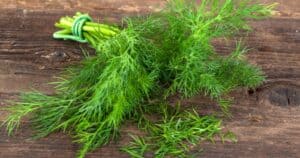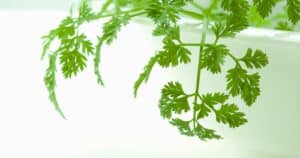Lemongrass is a herb with a zesty flavor with much to offer! Are you looking to
In this post, we’ll cover everything you need to know about lemongrass, from its origins and uses to its incredible health benefits. So let’s dive in and discover all there is to know about this flavorful herb!
First, we’ll explore the history and origins of lemongrass, including its many names and where it’s commonly grown. Then, we’ll delve into its uses in cooking and herbal medicine, including how it’s prepared and consumed.
We’ll also discuss the numerous health benefits of lemongrass, such as its antibacterial and anti-inflammatory properties and its potential to aid digestion, lower blood pressure, and reduce stress.
Finally, we’ll wrap up some tips for using lemongrass in your cooking and how to incorporate it into your daily routine for maximum health benefits. So please stick around and discover the wonders of lemongrass with us!
Origins of Lemongrass: A Brief History
Lemongrass has a rich history traced back to various Southeast Asian countries. The specific point of origin for Cymbopogon citratus, the most common species of lemongrass, is Malaysia. It has been cultivated in the region for over two thousand years and has been an integral part of Asian and African cultures.
East-Indian lemongrass (C. flexuosus) is another species of lemongrass native to India, Burma, Sri Lanka, and Thailand. For thousands of years, Asians and Africans have used lemongrass as a cooking ingredient and an herbal remedy. However, it was only in 1905 that the therapeutic essential oils of lemongrass were introduced to the West by a Sri Lankan.
The cultivation of lemongrass in Southeast Asia dates back to the early days of civilization. In ancient times, lemongrass was used primarily as a medicinal herb. In Malaysia, for instance, lemongrass tea alleviated various ailments such as fever, cough, and colds. Meanwhile, lemongrass oil was used in India for its antifungal and antibacterial properties.
Lemongrass also has a significant cultural value. For example, it is used in Thai cuisine to flavor soups, curries, and salads. The herb has a zesty flavor that compliments spicy and savory dishes. In some African cultures, lemongrass is used as a substitute for salt and is believed to have purifying properties.
The Various Names of Lemongrass
Lemongrass, also known as barbed wire grass, silky heads, Cochin grass, Malabar grass, oily heads, citronella grass, or fever grass, is a flowering plant native to tropical Asia, southern India. With over 50 species of grasses falling under the Cymbopogon genus, lemongrass is just one of the wide varieties.
The East-Indian lemongrass (C. flexuosus) is called Cochin or Malabar grass. Due to its popularity and wide distribution, lemongrass has various names across the globe.
For instance, in Brazil, it is known as Capim-video and Capim-Santo; in Egypt, it is known as Lemon Grass; and in Hindi, it’s known as Sera and Verveine.
Lemongrass is an herb commonly used in cooking, aromatherapy, and traditional medicine. Below are some of the various uses of lemongrass, including its nutritional value:
- In traditional medicine, lemongrass treats digestive issues, high blood pressure, asthma, fever, and other health conditions.
- The essential oil of lemongrass is often used in aromatherapy to reduce stress, improve mood, and aid in relaxation.
- Lemongrass is rich in antioxidants that help to protect the body from free radical damage.
- It is a good source of vitamins A and C, folic acid, magnesium, and potassium.
- In cooking, fresh or dried lemongrass adds a tangy, citrusy flavor to dishes like soups, curries, and marinades.
Culinary Uses of Lemongrass
The Culinary Uses of Lemongrass are genuinely endless! As a key ingredient in Southeast Asian dishes, Lemongrass adds a bright, citrusy flavor to everything from soups and stews to roasted meats and cocktails.
Here are a few of the many ways you can use Lemongrass in your cooking:
- Thai Curry Paste: Lemongrass is a critical ingredient in many Thai curry pastes, where its lemony flavor stands up to prolonged cooking. Blend fresh Lemongrass, garlic, chili peppers, and other herbs and spices to create a flavorful paste that can be used for various dishes.
- Lemongrass Tea: The outer leaves of Lemongrass can be dried and brewed into tea, which is said to have a wide range of health benefits. Lemongrass tea is also a delicious way to enjoy the bright, citrusy flavor of Lemongrass on its own.
- Flavored Oil: Lemongrass can infuse the oil with its bright, aromatic flavor. Heat some oil (such as coconut or olive oil) and add chopped Lemongrass stalks. Let the mixture steep for a few hours, then strain out the Lemongrass stalks and use the flavored oil in your cooking.
Herbal Medicine Benefits of Lemongrass
Lemongrass is a herb that is known to have many beneficial properties. It is often found in herbal medicine as it can treat several ailments ranging from stomachaches to high blood pressure. This herb is nervine that specifically supports the nervous system to combat symptoms of stress and anxiety.
It is known to be antibacterial, antifungal, antiseptic, antispasmodic, and diaphoretic. With its range of benefits, it is no wonder why lemongrass is touted as a miracle herb.
One of the primary benefits of lemongrass is its ability to alleviate anxiety. As a nervine herb, it acts as a natural sedative and helps to calm the nerves. It has been found to lower levels of stress hormones in the body, which helps to reduce feelings of anxiety and tension.
By incorporating lemongrass into your daily routine, you can alleviate some of the stress-related symptoms.
Another benefit of lemongrass is its ability to combat infection. It is antibacterial, antifungal, and antiseptic, making it highly effective against many conditions. Lemongrass has even been used to treat skin infections and wounds, as it helps to speed up the healing process.
Adding lemongrass to your diet or using it as an essential oil can help protect your body against harmful infections.
Lemongrass is also beneficial for digestive health. It is excellent for digestion and has been used to alleviate stomach aches, vomiting, and even fever symptoms. It acts as a natural diuretic, which helps to expel toxins from the body. Lemongrass tea is a great way to incorporate this herb into your diet and reap its digestive benefits.
Preparation and Consumption of Lemongrass
Lemongrass is a versatile herb that requires some preparation before cooking. First, make a few shallow cuts lengthwise along the stalk using a serrated knife. Then, lightly bend and squeeze the stem to release its flavors. When making tea, chop the stalk into pieces and steep it in boiling water for an aromatic infusion.
Lemongrass is an excellent ingredient for marinades and broths and can make delicious curry pastes. You can also add it to soups and curries to add a fresh flavor that can be removed later.
You can use lemongrass creatively to get the most out of lemongrass. For instance:
- For a refreshing and flavorful tea, add lemongrass to boiling water, then add sugar and lime wheels if desired.
- Mix lemongrass with other herbs and spices to make the aromatic seasoning for meat or vegetables.
- Combine lemongrass, rosemary, and thyme in a ceramic teapot with boiling water for a delicious herbal infusion.
Lemongrass has numerous health benefits, including aiding digestion, lowering cholesterol, and reducing inflammation. It is an excellent source of antioxidants and vitamins that can help boost your immune system. Not only is it good for your body, but it also adds a beautiful flavor to your cooking.
Try experimenting with lemongrass in different recipes to discover new ways to utilize this tasty herb.
Lemongrass Substitute
Does Lemongrass substitute? No problem! Plenty of great options if you don’t have lemongrass on hand. Cilantro, mint, and arugula have similar herbal notes that can replace lemongrass in your dish.
If you’re looking for a single-ingredient substitute, lemon or lime zest, lemon verbena, and kaffir lime leaves are all great options.
And if you’re feeling adventurous, try preserved lemon, coriander, ginger, or lemon balm.
But if you’re in a pinch, simple lemon zest can do the trick and is probably already in your kitchen.
Cilantro, mint, and arugula are leafy greens with unique flavors that can add depth to a dish, just like lemongrass.
Cilantro has a similar citrusy note, while mint adds a remarkable freshness. Arugula has a peppery bite that gives your dish a little kick.
If you’re looking for more specific substitutes, kaffir lime leaves are commonly used in Thai cuisine and have a similar flavor to lemongrass.
Lemon verbena and lemon balm have a citrusy flavor that can mimic that of lemongrass. And preserved lemon, made by soaking lemon slices in salt, can add a tangy, intense flavor that can replace the subtler taste of lemongrass.
Lemon zest is the most straightforward lemongrass substitute; you only need a lemon and a zester. Grate the lemon peel and add it to your dish. It adds a slightly sweet and sour flavor that can be an excellent substitute for lemongrass.





